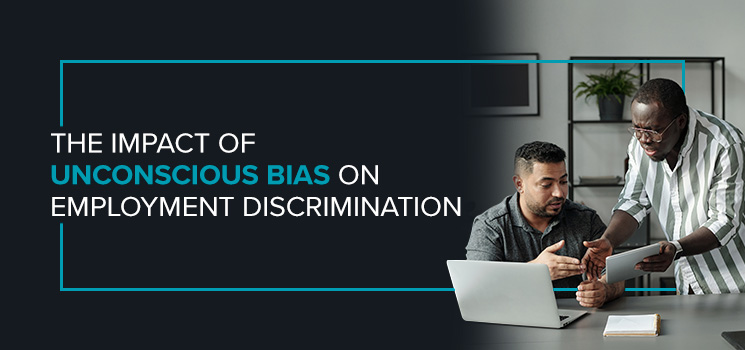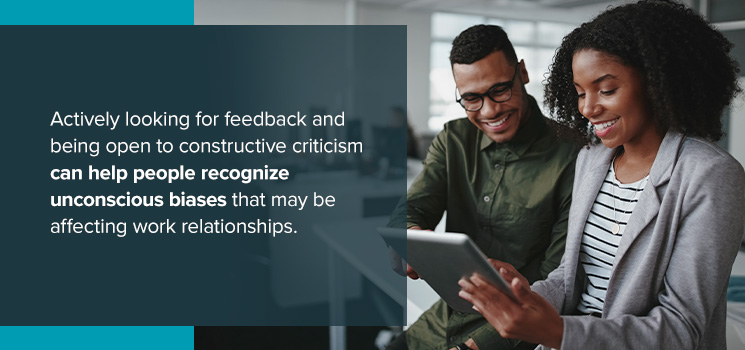By Weisberg Cummings, P.C. on September 28th, 2023
Unconscious bias can quietly influence workplace dynamics. It is the automatic judgments anyone can make about another person based on background, appearance or stereotypes, often without realizing it. This behavior can affect hiring practices, promotions and collaboration among colleagues. Recognizing unconscious bias is vital because it curbs diversity, hinders fair opportunities and obstructs innovations.
Addressing unconscious bias in the workplace fosters an inclusive environment where each employee’s potential can flourish. By acknowledging and mitigating these biases, organizations can become more equitable, empowering all individuals to contribute fully and authentically.
What Is Unconscious Bias?
Unconscious bias in the workplace relates to the subtle, automatic attitudes and stereotypes individuals may hold toward others based on their characteristics like gender, race, age or socioeconomic status. These biases form due to societal influences, upbringing, personal experiences or media portrayals. They often come up without a person being aware of it within themselves and can significantly impact how they perceive and interact with colleagues.
Influence on Perceptions
These perceptions can cause people to make quick judgments and assumptions without consciously realizing it. The result is often favoritism, exclusion or unjust treatment. In the workplace, unconscious bias can affect decisions related to hiring, career advancement opportunities and teamwork. For instance, a manager may unknowingly assign specific roles based on gender or make assumptions about an employee’s competence based on their ethnicity.
Types of Unconscious Bias
There are many forms of unconscious bias, though the most common are likely based on sex and race. Here are a few more examples of unconscious bias in the workplace:
- Appearance: This bias refers to wrongful assumptions about an employee’s skill set based on their appearance or weight.
- Halo effect: Particularly prevalent in the hiring process, this refers to the tendency to put someone on a pedestal when they reveal something impressive about themselves.
- Ageism: This bias refers to assumptions and general negative feelings about someone because of their age. Around 62% of workers over 50 feel they are more subject to age discrimination in the workplace.
- Nonverbal: This is where an applicant’s body language affects a decision or opinion. While some cues may indicate disinterest, it is essential to remember that body language is only part of a candidate’s communication and may result from other factors like health or personality type.
- Gender: This bias refers to a preference for one gender over another and making judgments about someone’s ability to complete certain tasks due to their gender.
- Conformity: This bias can relate to peer pressure, where some individuals act like those around them to feel accepted or included.
How Does Unconscious Bias Affect the Workplace?
The ingrained attitudes that shape perceptions can hinder fair decision-making in the workplace, as more value should be placed on diverse talents and ideas. This problem hampers engagement and employee retention. When employees face exclusion like this, 34% tend to withhold new ideas or solutions from their team.
While unconscious bias differs from discrimination in that it is not intentional, all employees must become acutely aware of their intentions and decision-making processes to curb the unjust treatment of others. For example, workplace bias may appear in:
- The hiring process: Applicants may not be considered for their skills or experience and instead be rejected due to bias. Many underrepresented individuals in the job market observe bias in the recruitment process. This bias can weaken the workforce over time.
- Unequal opportunities: Individuals who fit a mold may receive promotions rather than counterparts who may outperform them.
- A pay gap: A pay gap can occur when gender or racial bias creates inconsistency in employee remuneration, not based on their skills, experience or performance.
- Poor collaboration: Bias can create a work environment where employees are uncomfortable or unmotivated to contribute, leading to less team collaboration and closed-off communication.
Recognize Unconscious Bias
It can be challenging to identify unconscious bias, as recognizing it is an internal process. Taking the time to reflect on interactions and decisions can help identify any prejudice that may influence behavior at work. Actively looking for feedback and being open to constructive criticism can help people recognize unconscious biases that may be affecting work relationships. Regular self-assessment and a commitment to personal growth can empower individuals and teams to foster a respectful, innovative and harmonious workplace.
How to Mitigate Unconscious Bias
Fostering awareness is key to mitigating unconscious bias, as diverse and inclusive companies can achieve more growth. Education enables recognition and correction of preconceptions. Inclusive policies and diverse leadership enhance representation and build an equitable work environment. Additionally, emphasizing individual strengths cultivates appreciation for various contributions, while conscious efforts to counteract bias create more substantial teams, boosting productivity and morale. An inclusive workplace nurtures personal growth and elevates overall success.
By proactively implementing these steps, organizations can create a more honest and inclusive work environment where everyone has the opportunity to thrive:
- Awareness: Actively acknowledge the existence of unconscious bias in the workplace and the importance of employees recognizing this within themselves. Ensure employees know their options if they receive feedback or treatment based on bias.
- Education: Follow up the awareness point with education. Diversity and inclusion training can increase understanding, benefit the recruitment process and strengthen working relationships.
- Anonymity: Implement blind recruitment to reduce bias during hiring.
- Feedback culture: Encourage open discussions about workplace bias to foster a learning culture.
- Fair policies: Develop unbiased policies to guide reviews, evaluations and promotions.
- Mentorship: Establish mentorship programs in the company to support underrepresented employees.
- Data analysis: Regularly assess workplace data for bias patterns.
- Accountability: Hold individuals accountable for addressing and minimizing bias.
- Diverse panels: Ensure that there are varied perspectives in decision-making groups.
Avoid Unconscious Workplace Bias
In addition to staff training about the dangers and signs of unconscious bias, organizations can include policies to ensure discrimination does not slip through the cracks when it comes to essential processes within the company:
- Set pay: Base payment on a mathematical equation of experience, education and performance.
- Promotional structure: Base promotions solely on job performance and experience. When an employee meets set requirements in these categories, they have consideration.
- Reviews template: Hire a third party to review the recordings on the previous points to ensure fairness in processes.
Know Your Rights With Weisberg Cummings
Addressing unconscious bias requires self-awareness, education and deliberate efforts to counter these automatic tendencies. By recognizing and mitigating these biases, workplaces can create a more inclusive and unbiased environment that values the contributions of all employees.
Weisberg Cummings is a Pennsylvania law firm with over 40 years of combined experience in workplace discrimination. We take the time to understand your situation before offering practical legal solutions. If you think you are subject to unconscious bias or outright discrimination in the workplace, take advantage of our free consultation to determine your next steps.



